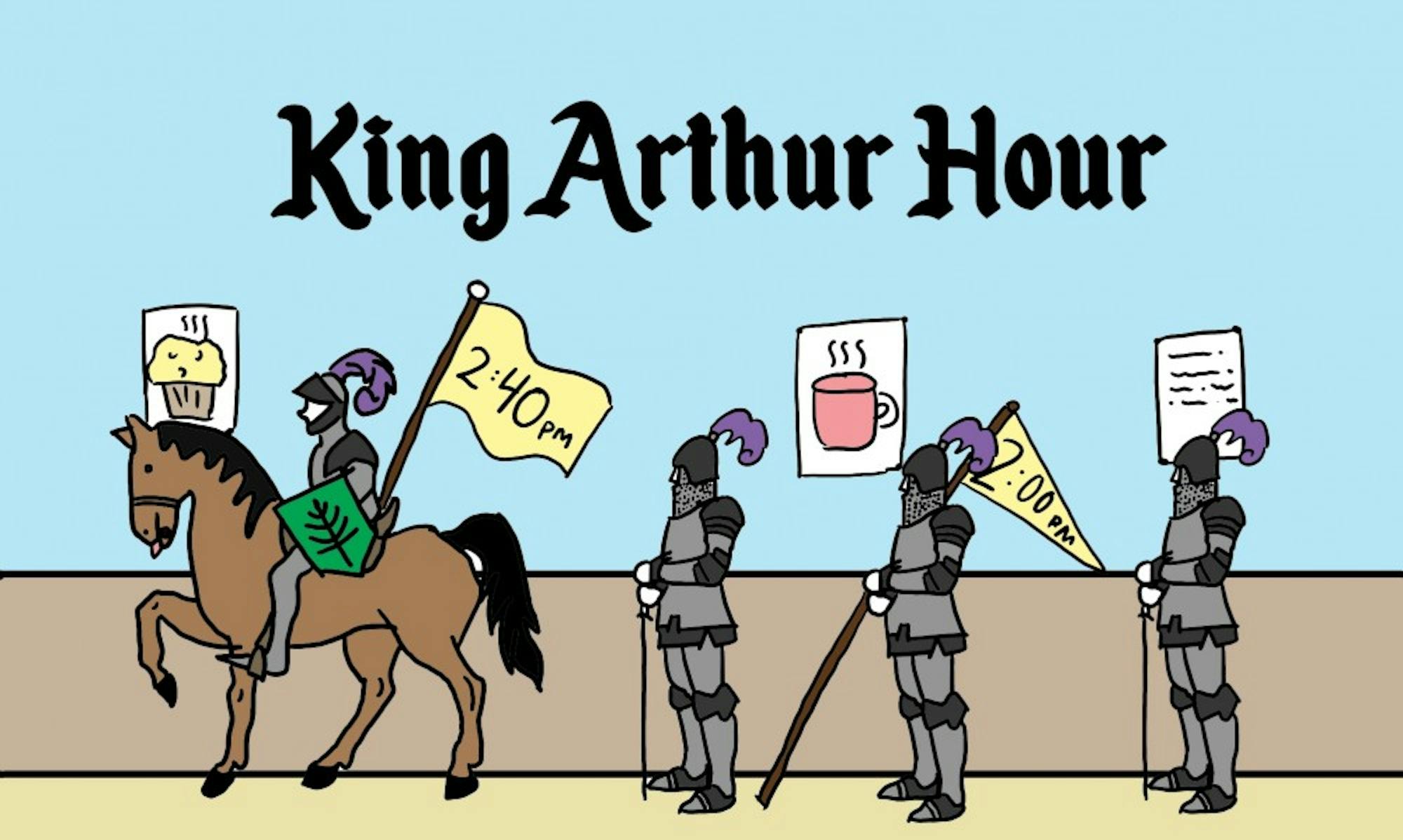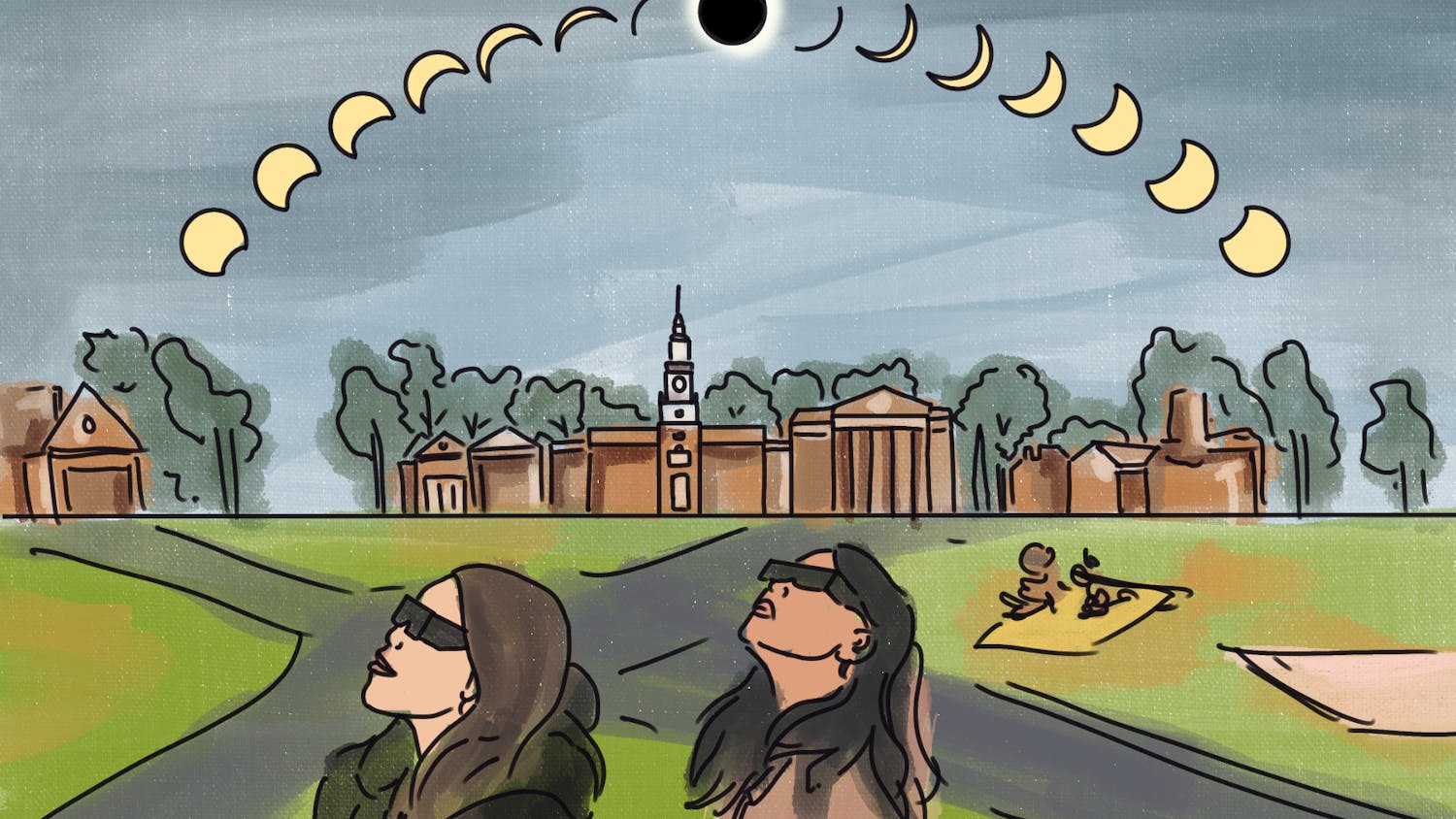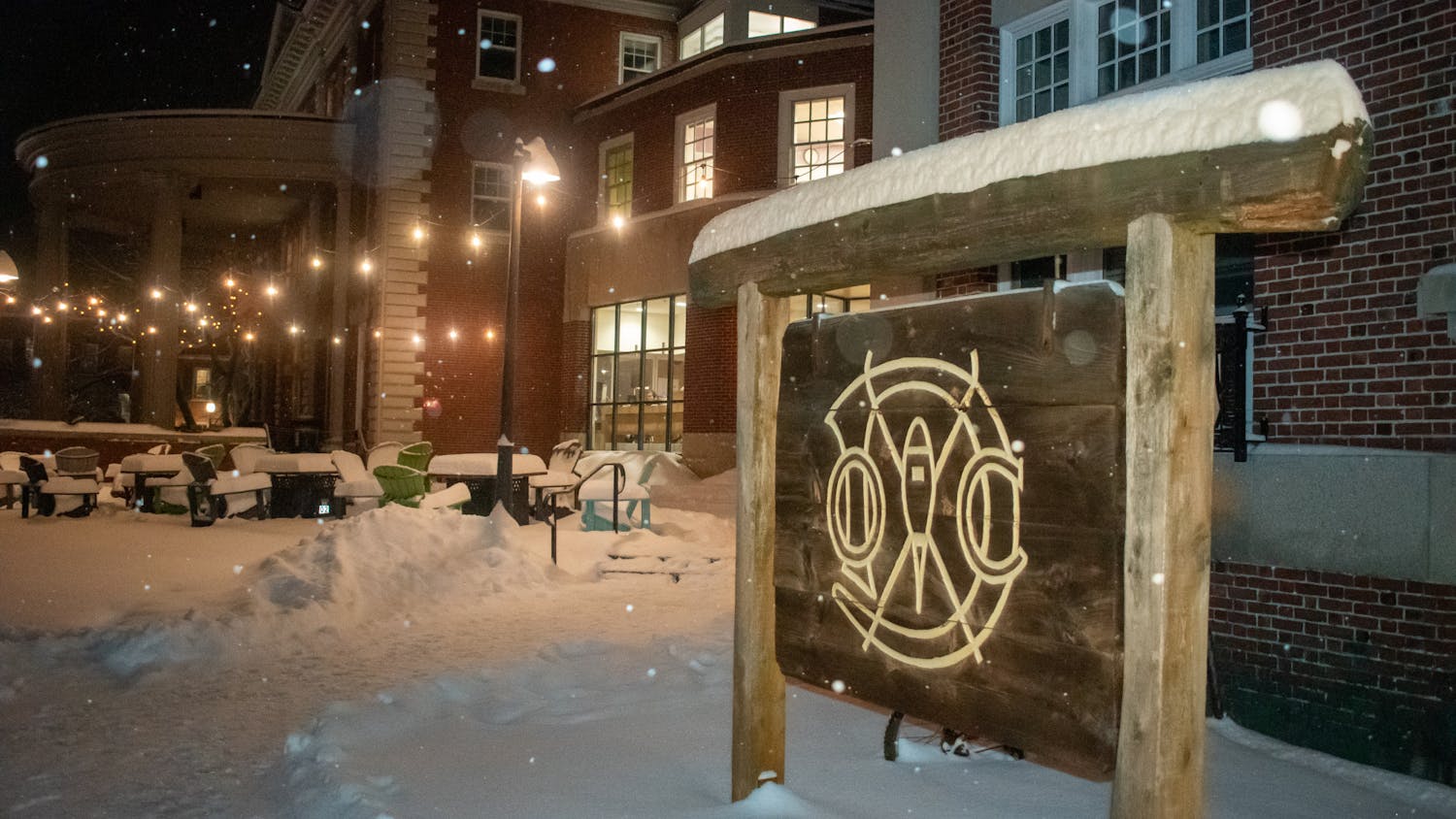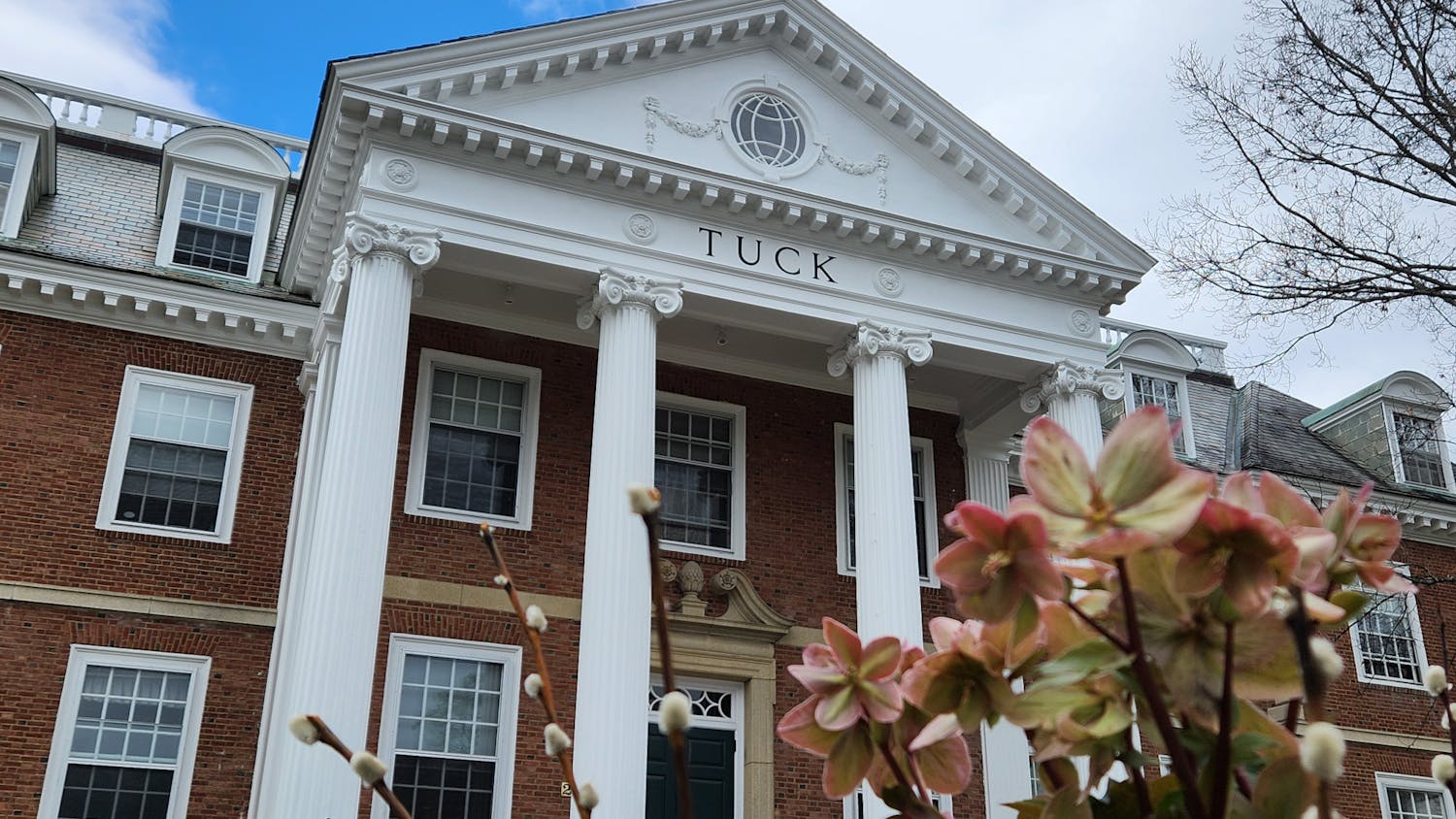2:40 p.m. I step into the main line of King Arthur Flour, placing myself right behind the other three customers extending outside of the entrance. It’s a Monday afternoon and 2s started half an hour ago, so I’m not expecting the in-between-classes rush. The line’s a little longer than I’d prefer, but I’ve seen worse.
2:45 p.m. I’ve finally made it through the entrance. The person in front of me, a girl wearing a mustard yellow sweater, suddenly notices her friends closer to the front. Without hesitation, she cuts over half the line; no one says anything. I look back, see that the line’s even longer now than it was when I hopped on, and decide that I should focus on the positive.
2:58 p.m. I’m nearly at the front of the line, and I realize that I’m not yet sure what I want. I’m craving some caffeine, but I’m not a big fan of coffee’s bitterness. I could also go for a snack — nothing too sweet.
3:00 p.m. Finally! I place my order: a chocolate milk with an espresso shot and a plain croissant. A simple order, sure, but my patience is wearing thin. The barista at the register hands me my croissant right away and the chocolate milk comes out a minute later.
3:01 p.m. Out of curiosity, I walk back to the end of the line to see how it’s looking 20 minutes later. It now extends eight people past the entrance — even longer than before.
If I were in a café back home, the idea of waiting 20 minutes just for a chocolate milk and a croissant would seem a little ridiculous. At Dartmouth, however, we’ve become so conditioned to long lines that waiting 20 minutes might even seem fortuitous — we students know from experience that the wait could have easily been even worse.
Morgan Pak ’21 takes waiting in lines very seriously. She explained that because she lives in the McLaughlin Cluster, she goes to KAF for food more often than other dining locations on campus that are farther away from her dorm. She admitted that she’s not the best at estimating time, but she guesses that she usually spends around 10-15 minutes, or at the most 20 minutes, waiting in the KAF line every day.
“It’s a joke with my friend that we spend most of our lives in the KAF line,” Pak said. “Before my 10 — I didn’t think people would be up that early in the morning. But they are.”
When asked if she has any strategies to avoid lines, Pak said that she will avoid certain dining locations during certain times. For example, she advises against going to Collis Café right after 11s, going to the Courtyard Café between 5:00 p.m. and 7:00 p.m. or going to the Class of 1953 Commons between 6:00 p.m. to 7:00 p.m.
She said she has noticed that there are certain times of the day when lines seem shorter, but she said that anticipating shorter lines can be “hit or miss” depending on the day. She also emphasized that on the weekends, when both KAF and Collis Café are closed during the day, lines elsewhere can feel even longer as a result of students having fewer options.
Natalie Chertoff ’18 is another student who shared her feelings about food lines around campus. She is originally from Brooklyn, where she’s used to having many café options on a single block, so she’s not accustomed to the long lines that arise from having so few choices.
Chertoff said that most of her waiting in lines happens at Collis and KAF but that given her busy schedule, she’s sometimes tempted to choose somewhere else to eat just so she doesn’t have to wait as long. When the KAF line is especially long, she might even decide to go to a café in town instead.
Like Pak, Chertoff pays close attention to the time of day in order to avoid the usual rushes.
“If I want Collis, I’ll usually get dinner super early — at 5 or 5:30 — to avoid lines,” she said. “I tend to avoid going to [KAF] right when a class is about to start or when a class just gets out because I feel like lines are shorter then.”
Thinking back to how long waiting in lines took when she arrived at Dartmouth, Chertoff thinks that lines take longer now — although she’s not sure if that feeling is supported by statistics or is just a byproduct of her busier schedule.
One feeling that is definitely justified: feeling frustrated when students cut lines. Chertoff isn’t very bothered when it’s only one student cutting the line, admitting that she’s done it herself before, but she said that it’s worse when a large group cuts the line. She has noticed that this happens toward the end of a term, when students with a lot of DBA left will pay for their friends’ food in addition to their own.
Overall, Chertoff believes that at cafés like KAF, lines will always be long, but she does wonder if lines would move more efficiently if more employees were hired. At a place like Collis, she thinks that introducing more options could reduce lines by moving people away from the same usually-crowded stations.
It’s clear that many students have strong opinions on campus lines, but what goes on behind the scenes to regulate those lines?
Don Reed, the associate director of Dartmouth Dining Services, noted that one of the key challenges of managing lines at the Courtyard Café and at Collis Café is the fact that so many students want made-to-order dishes. With few exceptions, like Collis’s breakfast sandwiches, these items simply can’t be prepared ahead of time.
“[Students] like the ability to change an ingredient, add an ingredient or get it the way they like it,” Reed said. “You get one of those [students ordering] ahead of you, and the line is going to slow down.”
The made-to-order lines may be hard to shorten, but Reed emphasized the importance of cooler space in each dining location. Inside these coolers are pre-prepared food and drinks, ranging from sandwiches to wraps to fruit cups to even microwavable meals. Students looking to avoid long lines can grab these refrigerated items to purchase instantly.
Unlike the Courtyard Café and Collis Café, the Class of 1953 Commons usually doesn’t have extremely long lines, due to both its size and staff preparation. Inside the kitchen walls, there are even printed class schedules so that cooks know when to prepare for after-class rushes throughout the day. Reed suggested waiting an extra 10-15 minutes after a class block has ended to avoid the longest of lines.
Reed said that, in general, DDS is making efforts to attract students to the Class of 1953 Commons. For example, recent changes have included a do-it-yourself omelet station and adding new types of fruits to the Saturday brunch menu. These changes are intended to make students feel that the Class of 1953 Commons is the best use of their meal swipes during peak meal times — that way, they’ll be less likely to contribute to the long lines in other dining locations.
Even for big events in the '53 Commons where big lines are the norm, such as the Harvest Dinner every fall term and the first “A Night in Italy” event earlier this term, DDS takes notes and constantly makes improvements. For example, the 2017 Harvest Dinner had some stands placed in the “dark side” to more evenly spread things out, while for next year’s Italian dinner, Reed would like to see the Pavilion and Herbivore stations better utilized.
Chris Robbins, the manager of Novack Café, is also used to dealing with lines on a daily basis. He’s been Novack’s manager for slightly less than two years, and he said that even before he arrived, Novack’s team has prioritized line efficiency.
For example, Robbins described Novack’s transition from ringing up items on a screen to scanning the bar codes. Worried about increased waits, Robbins used a stopwatch to track changes.
“When I first got here, we switched to scanning,” Robbins said. “One of the keys was we did not want to slow our line time down by scanning.”
At first, the learning curve of scanning items did increase the time that customers waited in line, but with close attention and awareness, eventually wait times went back down. Now, Robbins said, it’s evident that scanning items is faster than manually ringing up items ever was.
Robbins is pleased with the current state of Novack’s line management. He notes that he and his team go through the class schedule to learn when to anticipate rushes, and employees behind the bar are ready to go one minute before the crowd arrives. When there isn’t a crowd, Novack employees take advantage of the calm to instead ensure that items don’t run out.
“You’ll notice before and after rushes, we have people stocking and filling up things,” Robbins said. “During a rush, it’s all hands on deck.”
Robbins had only positive things to say about Novack’s employees, especially its student employees. He appreciates how student managers and supervisors, who have worked at Novack for several years and risen through the ranks, are always using their experience to train and mentor newer employees.
He acknowledged too that sometimes, Novack employees can have a reputation for being quick to scream “ready to help the next customer!” across the counter. He explained that there’s a careful balance between providing excellent, quick customer service and treating customers in a respectful and welcoming way. He continued, adding that while sometimes things behind the counter need to be dialed back a bit, his employees always try to respect customers’ schedules.
“I would say that most of the time when [yelling] happens, it’s because the people behind the counter really care about moving [lines] as much as possible,” Robbins said. “They realize that the guy in the back has a class to get to, or the girl 15 people back has somewhere to be.”
While for many Dartmouth students, long lines have become a normal part of life, not all students are willing to just sit back and remain passive. Jin Hyun Cheong, a 3rd year graduate student, and Eshin Jolly, a neuroscience PhD candidate, are two graduate students who are taking matters into their own hands: they are the co-founders of “Line at KAF,” an in-development phone app that can tell users how long the KAF line is at any given moment.
Both Cheong and Jolly enjoy going to KAF for coffee, especially given its proximity to their offices in Moore Hall, but they began to grow frustrated with the extremely long lines. About two years ago, they began wondering if there could be a way to know how long the KAF line is.
Unlike undergraduate students, Cheong and Jolly are not familiar with the undergraduate class schedule, so their motivation was furthered by being unable to figure out when peak rush hours were.
“We’re less versed in the Dartmouth schedule … so we would actually never figure out when would be the ideal time to go,” Cheong said. “That was the other motivation: since we don’t know, how can we figure that out and also help other people?”
When asked about how Dartmouth lines compare to lines at their own undergraduate institutions — Cheong attended Princeton University, and Jolly attended the University of Rochester — neither could remember any particularly notorious lines. Cheong remembered that the cafeterias at Princeton were more spaced out with different stations and Jolly remembered one café that, thanks to live student musical performances, made waiting in line feel less tedious.
Line at KAF started out as a HackDartmouth entry, and after gaining the community’s attention and support from the Digital Arts, Leadership and Innovation Lab, the project has grown immensely. Without going into too much of the science behind the app, Cheong and Jolly explained that the app takes advantage of Raspberry Pis, small single-board computers, embedded in the ceiling above the KAF lines to track the lengths of both the main KAF line and the Baker lobby line in real-time.
“Right now, a lot of people have to play the guessing game when they try to stand in [one line or the other],” Cheong said. “Once you have an idea of how many people are in each line, you can make an informed decision about which line is faster.”
As for the future of the app, the team hopes to start beta testing this summer for a full launch this fall. While the app is currently only designed to track line length, Cheong and Jolly have both met with KAF officials to discuss potential future additions. Keeping track of which menu items are out of stock and ordering online are both ideas that could someday become a reality.
For better and for worse, lines are a ubiquitous part of the Dartmouth experience. Whether you’re someone who avoids lines professionally or someone who will do anything to get your caffeine fix, one thing is sure: both students and administration are working to make lines shorter and improve the student experience.
As for how fast these changes come and how effective they’ll be: we’ll just have to wait.




